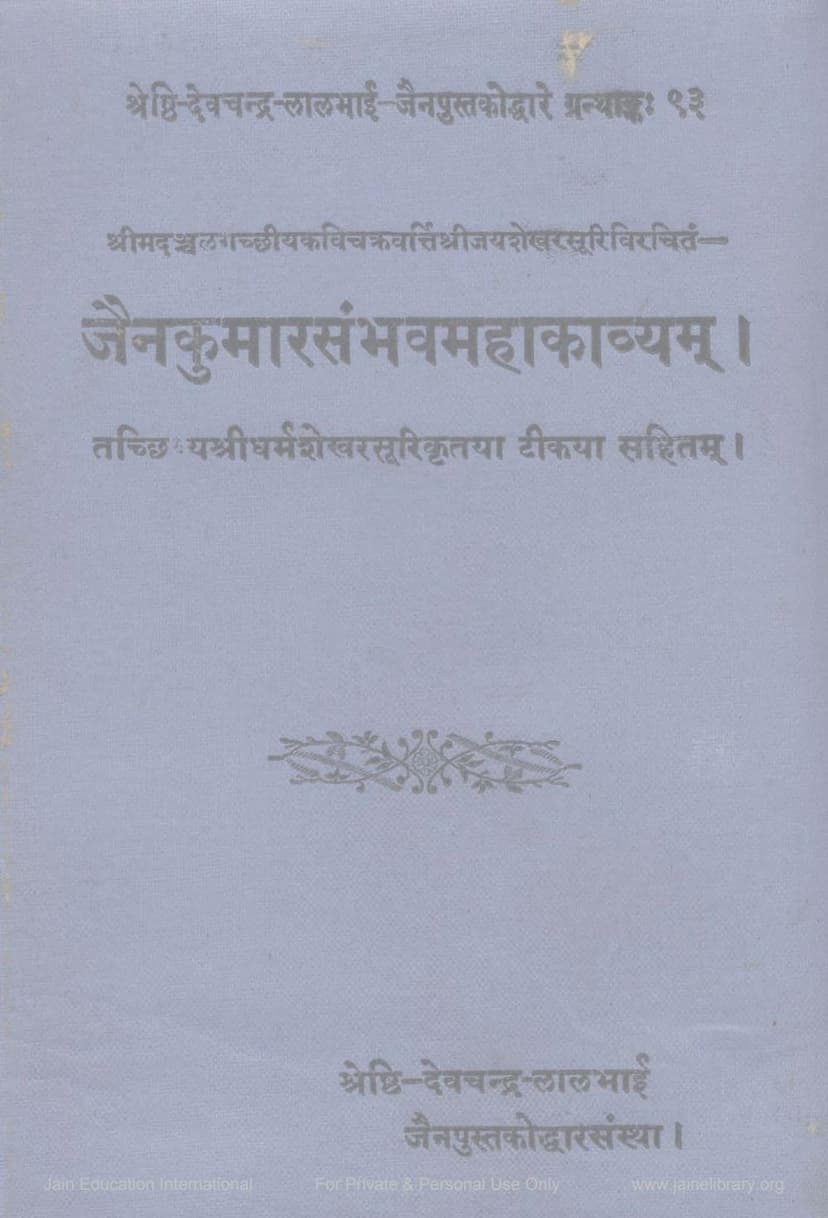Jain Kumar Sambhava Mahakavyam
Added to library: September 2, 2025

Summary
Here's a comprehensive summary of the Jain text "Jain Kumar Sambhava Mahakavyam," based on the provided catalog link and the Gujarati text from the pages:
Title: Jain Kumar Sambhava Mahakavyam (जैनकुमारसंभवमहाकाव्यम्) Author: Shri Jayashekhar Suri (श्री जयशेखरसूरि) Commentary Author: Shri Dharmashekhar Suri (श्री धर्मशेखरसूरि) Publisher: Seth Devchand Lalbhai Jain Pustakoddhar Fund (श्रेष्ठि-देवचन्द्र-लालभाई-जैन-पुस्तकोद्धार-संस्था) Publication Year: Vikram Samvat 2002 (1946 AD) Series Number: 93
Overview:
The "Jain Kumar Sambhava Mahakavyam" is a significant Jain Mahakavya (epic poem) composed by the renowned Jain scholar and poet Acharya Shri Jayashekhar Suri, belonging to the Anchal Gacch. The work is presented with a detailed and lucid commentary by his disciple, Acharya Shri Dharmashekhar Suri. The Mahakavya draws inspiration from the famous "Kumarasambhava" of Kalidasa, but its narrative focuses on the life and deeds of the first Jain Tirthankara, Lord Rishabhadeva, and his son, Bharat Chakravarti.
Content and Themes:
-
Narrative Focus: The poem narrates the birth and life events of Lord Rishabhadeva, considered the progenitor of civilization and the first spiritual guide in the current era of Jainism. It particularly highlights the story of his son, Bharat Chakravarti, who, like Kartikeya in Kalidasa's epic, is a central figure. The name "Kumarasambhava" itself refers to the "birth of the prince" or "birth of the divine child."
-
Inspiration from Kalidasa: The author, Shri Jayashekhar Suri, was inspired by Kalidasa's "Kumarasambhava" and has structured his poem in a similar grand style, adhering to the conventions of a Mahakavya.
-
Spiritual and Moral Purpose: Echoing the core philosophy of Jain literature, the primary aim of this Mahakavya is not mere entertainment but the propagation of virtue and spiritual upliftment. The poem seeks to eradicate negative tendencies and guide readers towards ideal human conduct and liberation.
-
Poetic Excellence: The text is lauded for its elegant language (padalalitya), profound meaning (arthagaurav), rich emotional content (rasapurti), and skillful use of various literary devices, including phonetic embellishments (shabdalankar) and semantic artistry (arthalankar).
-
Narrative Elements: The poem includes the birth of Lord Rishabhadeva, his childhood, his marriage to Sunanda and Sumangala, his observation of fourteen auspicious dreams (which portend the birth of a Chakravarti), and the subsequent events leading to the birth of Bharat Chakravarti. It also features beautiful descriptions of seasons, morning, and other natural phenomena, common in classical Indian epics.
-
Theological Context: The work is deeply rooted in Jain cosmology and philosophy, portraying Lord Rishabhadeva as a divine being who descended to earth to guide humanity towards righteous living, spiritual knowledge, right faith, and right conduct (the three jewels of Jainism).
-
The Commentary: The commentary by Shri Dharmashekhar Suri is praised for its clarity and simplicity, making the profound verses accessible to a wider audience, including beginners. The commentator explains his approach as providing concise yet comprehensive explanations, sometimes through synonyms or brief analyses.
-
Inspiration for the Poem: The preface mentions a fascinating account where Acharya Shri Jayashekhar Suri, while in deep meditation in Khambhat (Stambhatirtha), received inspiration from the goddess Saraswati herself, who prompted him to compose this Mahakavya, even providing the opening verses of Kalidasa's "Kumarasambhava" as a starting point. The poet himself also mentions receiving divine inspiration ("Vanidatta Varah") in the final verse of his work.
-
Author's Identity and Lineage: Acharya Shri Jayashekhar Suri was a prominent figure of the Anchal Gacch, a disciple of Acharya Shri Mahendraprabha Suri. His works suggest a lineage of significant gurus within his tradition. Based on historical records, he is estimated to have lived in the late 14th and early 15th centuries of the Vikram era. He was proficient in Sanskrit, Prakrit, and Gujarati languages, as evidenced by his other works.
-
Editorial and Publication Details: The text was meticulously researched and edited. The preface notes the contribution of the late Acharya Shri Vijayakshmabhadr Suri in the initial editing process, which was completed by Muni Vikram Vijay after his unfortunate passing. The publication by the Seth Devchand Lalbhai Jain Pustakoddhar Fund reflects their commitment to preserving and disseminating valuable Jain literature.
Significance:
The "Jain Kumar Sambhava Mahakavyam" is a masterpiece of Jain literature, blending profound spiritual teachings with exquisite poetic artistry. It serves as a vital source for understanding the life and teachings of Lord Rishabhadeva and the Jain worldview, presented in a manner that is both intellectually stimulating and spiritually uplifting. The detailed commentary makes it an invaluable resource for scholars and devotees alike.